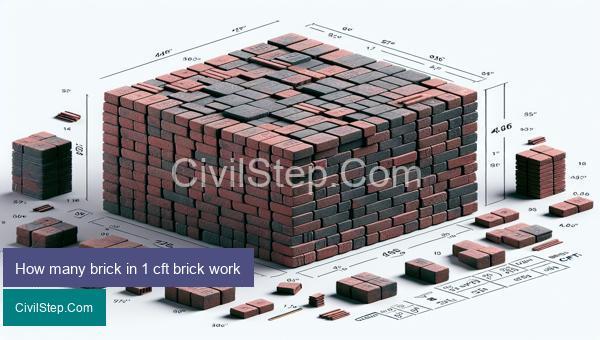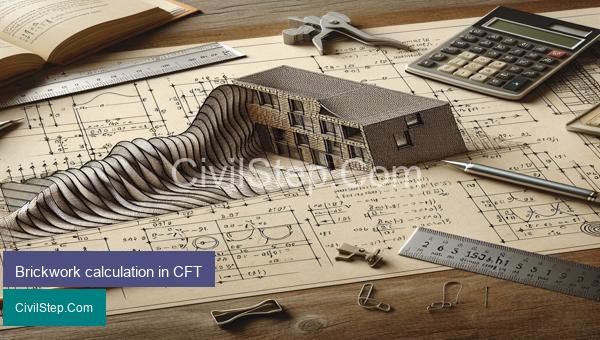
Bricks are one of the oldest and most commonly used building materials, dating back thousands of years. They are known for their durability and strength, making them a popular choice for construction projects. But when it comes to using bricks for building, proper planning and accurate calculations are essential for a successful construction project. In this article, we will delve into all the important aspects of brickwork, specifically focusing on the calculation of 1 cft (cubic feet) of bricks and their usage. So whether you’re a homeowner looking to build a brick wall or a professional in the construction industry, this article will provide you with all the necessary information about bricks and their calculation in 1 cft brickwork.
How many brick in 1 cft brick work & their calculation

Bricks are one of the most important construction materials used in civil engineering projects. They are strong, durable, and easy to work with. In brickwork, bricks are arranged and bonded together using mortar to create walls, columns, and other structures. As a civil engineer, it is crucial to know the number of bricks required for a specific project and their proper calculation for efficient and cost-effective construction.
The measurement of bricks and brickwork is typically done in cubic feet (cft) in India, while in most countries, it is measured in cubic meters (m³). The standard size for a brick in India is 9″x4.5″x3″ (length, width, and height). Therefore, 1 cft brickwork can be defined as a volume of brickwork which covers an area of 1 cubic foot with bricks laid in it.
Calculating the number of bricks in 1 cft brickwork involves several steps:
Step 1: Find the volume of 1 brick
The volume of a brick can be calculated by multiplying its length, width, and height. Using the standard size of a brick mentioned above, the volume of a brick would be 9×4.5×3 = 121.5 cubic inches.
Step 2: Convert the volume to cubic feet
There are 12 inches in a foot, so we need to convert the volume from cubic inches to cubic feet. Therefore, the volume of 1 brick in cubic feet = 121.5/12³ = 0.00545 cft.
Step 3: Calculate the number of bricks required for 1 cft brickwork
To determine the number of bricks required for 1 cft brickwork, we need to know the volume of the brickwork. For example, if the brickwork area is 100 square feet and the thickness of the wall is 4 inches, the volume of the brickwork would be:
Volume of brickwork = Area x Thickness = 100 sq ft x (4/12) ft = 100/3 cft
Therefore, the number of bricks required for 1 cft brickwork can be calculated as follows:
Number of Bricks = Volume of Brickwork/Volume of 1 brick
= (100/3)/0.00545 = 18,348 bricks.
In short, for 1 cft brickwork with a standard brick size of 9″x4.5″x3″, the number of bricks required would be approximately 18,348 pieces. However, this number may vary depending on the different brick sizes and types used in the construction.
In conclusion, as a civil engineer, it is crucial to accurately calculate the number of bricks required for a project to ensure proper budgeting and efficient construction. This calculation can also help in estimating the time and labor required for the project. It is essential to consider the brick sizes and types, as well as other factors like waste and breakage during the calculation process.
How many brick in 1 cft brick work

The number of bricks in 1 cubic foot (cft) of brickwork varies depending on the size and type of brick being used. Typically, standard clay bricks measure 8 inches by 4 inches by 2 inches and weigh around 5 pounds. Using these standard dimensions, we can calculate the number of bricks in 1 cft of brickwork.
First, we need to convert cubic feet to cubic inches by multiplying the value by 1728 (1 cubic foot = 1728 cubic inches). This gives us 1728 cubic inches of brickwork.
Next, we need to account for the mortar joints between the bricks. The typical thickness of a mortar joint is 3/8 of an inch. Therefore, we subtract 3/8 of an inch from the width and height of the brick (8-3/8 inches by 4-3/8 inches) to get the net dimensions of the brick.
Now, we calculate the volume of a single brick using the net dimensions. V = l x b x h, where V is volume, l is length, b is width, and h is height. Therefore, the volume of a single brick is 8 x 4 x 2 = 64 cubic inches.
To find the number of bricks in 1 cft of brickwork, we divide 1728 cubic inches by 64 cubic inches (1728/64 = 27). This means that there are 27 bricks in 1 cft of brickwork.
However, this number can vary if different sizes of bricks are being used. For example, if using modular bricks that measure 8 inches by 3-5/8 inches by 2-1/4 inches, the number of bricks in 1 cft of brickwork would be 30.
In conclusion, the number of bricks in 1 cft of brickwork can range from 27 to 30, depending on the size and type of bricks being used. It is important to consider the dimensions of the bricks and the thickness of the mortar joints when calculating the quantity of bricks needed for a specific project.
Brickwork calculation in CFT

Brickwork is a fundamental aspect of civil engineering design, involving the calculation and measurement of materials needed for constructing walls, partitions, and other structures using bricks. The unit of measurement for the brickwork is cubic feet (CFT), which is commonly used in the construction industry.
The calculation of brickwork in CFT involves determining the number of bricks required for a given structure. This calculation is essential in estimating the material cost and ensuring the efficient use of materials during construction. There are various methods used in brickwork calculation, such as the proportion method, the modular method, and the empirical method. However, the most commonly used method is the empirical method. Let us discuss in detail how brickwork is calculated in CFT using the empirical method.
Step 1: Determine the size of the brick
The first step in brickwork calculation is to determine the size of the brick. The standard size of a brick is 9 inches by 4.5 inches by 3 inches (length x width x height).
Step 2: Determine the net volume of brickwork
The net volume of brickwork refers to the volume of the space left after the deduction of joints. The standard value for joint thickness is 0.5 inches. Therefore, the net volume can be calculated as follows:
Net volume of brickwork = Gross volume of brickwork – Volume of joint mortar
Step 3: Determine the number of bricks required per CFT
To calculate the number of bricks required per CFT, we first need to find out the volume of a single brick. This can be done by multiplying the length, width, and height of the brick. In this case, it will be 9 x 4.5 x 3 = 121.5 cubic inches.
Next, we convert the volume of one brick into CFT by multiplying it with the conversion factor of 0.000578704. This results in 0.07 CFT per brick.
Finally, to determine the number of bricks required per CFT, we divide 1 CFT (which is the standard unit measurement) by 0.07 CFT, which gives us approximately 14.3 bricks per CFT.
Step 4: Calculate the number of bricks required for the entire structure
To calculate the total number of bricks required for the entire structure, we take into consideration both the net volume of brickwork and the number of bricks required per CFT.
Total bricks required = Net volume of brickwork x Number of bricks per CFT
Step 5: Factor in wastage and add mortar
It is essential to factor in wastage and add mortar to the total number of bricks calculated in the previous step. Wastage is typically estimated to be around 4-5%, and the amount of mortar used varies depending on the thickness of the joint. For example, if the joint thickness is assumed to be 0.5 inches, then the mortar volume would be 0.015 CFT per brick. This value will be multiplied by the total number of bricks, and the result is then added to the total number of bricks to obtain the final value.
In conclusion, brickwork calculation in CFT involves determining the number of bricks required per CFT and factoring in wastage and mortar. This calculation plays a crucial role in estimating the required materials and costs for constructing a brick structure. Therefore, accuracy in brickwork calculation is essential in ensuring the efficient use of materials
Conclusion
In conclusion, knowing the basics of brickwork and how to calculate the number of bricks required for a project can greatly benefit builders and homeowners alike. By understanding the dimensions of a standard brick and its composition, one can easily determine the quantity needed for a specific area. Additionally, being aware of the various types of bricks available and their features can help in making informed decisions for a construction project. By following the simple steps outlined in this article, anyone can accurately estimate the number of bricks needed for their desired project. With this knowledge, individuals can save time, money, and avoid any potential setbacks in their brickwork.
